#proto jungle
Explore tagged Tumblr posts
Text
youtube

Release: May 29, 1989
Lyrics:
Back to life, back to reality
Back to life, back to reality
Back to life, back to reality
Back to the here and now, yeah
Show me how decide
What you want from me
Tell me, maybe I could be there for you
How ever do you want me
How ever do you need me
How ever do you want me
How ever do you need me
How ever do you want me
How ever do you need me
How ever do you want me
How ever do you need me
Back to life, back to the present time
Back from a fantasy, yes
Tell me, now, take the initiative
I'll leave it in your hands until you're ready
How ever do you want me
How ever do you need me
How ever do you want me
How ever do you need me
How ever do you want me
How ever do you need me
How ever do you want me
How ever do you need me
How ever do you need me
How ever do you need me
How ever do you need me
How ever do you need me
I live at the top of the block
No more room for trouble and fuss
Need a change, a positive change
Look, it's me writing on the wall
How ever do you want me
How ever do you need me
How ever do you want me
How ever do you need me
How ever do you want me
How ever do you need me
How ever do you want me
How ever do you need me
Back to life, back to the day we have
Let's end this foolish game
Hear me out, don't let it waste away
Make up your mind so I know where I stand
How ever do you want me
How ever do you need me
How ever do you want me
How ever do you need me
How ever do you want me
How ever do you need me
How ever do you want me
How ever do you need me
How ever do you want me
How ever do you need me
How ever do you want me
How ever do you need me
Songwriter:
How ever do you want me
How ever do you need me
How ever do you want me
How ever do you need me
Nellee Hooper / Simon Law / Caron Wheeler / Beresford(b Romeo
SongFacts:
👉📖
#Youtube#Spotify#Soul II Soul#Back to life#hit of the day#music#music video#video of the day#youtube video#chaos radi o#good music#80s#80s charts#80s music#80s nostalgia#1989#contemporary r&b#r&b#house#proto jungle#pop#pop soul#uk street soul#breakbeat#hip hop#lyrics#songfacts#282
2 notes
·
View notes
Text
Chickens likely domesticated themselves the same way wolves did which is basically by hanging around our settlements and eating our refuse.
Living with chickens in this sort of way was likely happening way before the estimated times of 8,000- 10,000 years ago. The relationship was likely already long established it was just during that time some chickens started developing smaller/weaker adrenal glands which caused them to become much easier to raise and handle which eventually lead to the domesticated chicken we know of today (and how that happened so suddenly is a completely different but very interesting topic)
Also due to this you could argue that there isn't any true wild red jungle fowl left untouched and uninfluenced by humans anymore. Not only due to constant cross breeding with domestic chickens but because red jungle fowl are still doing what their ancestors did in their current range, if there is a town or village nearby the bravest junglefowl will still choose to intermingle with the village and eat the refuse, agricultural byproducts, and waste. People will still catch and care for these "wild" birds like their ancestors did. This isn't to say we shouldn't try our best to preserve the wild red jungle fowls wild genetics, their should be populations left to be in their natural environment but it's likely they are not truly same wild birds they once were thousands of years ago and honestly that's OK because thats how its been for thousands of years.
#basically domestic chickens suddenly became so wide spread so suddenly those thousands of years ago because a chinese ruler was like#i need to feed my people and im going to use these birds to do it#so they selected for big birds who were calm so they wouldnt freak out and burn calories#and they selected for less rooster to rooster aggression so they could house large amounts of birds together#and those birds were basically proto cochins#also game birds are very simialr to wild jungle fowl since their adrenals are physically different then asiatic breeds and their derivatives#they like have their own things going on im not getting into right now but#its all very cool and fascinating#also by learning this i learned that a lot of the older breeders in america think that like chicken breeds just#came unto existence via god??#Christian fundamentalism is wild
240 notes
·
View notes
Text
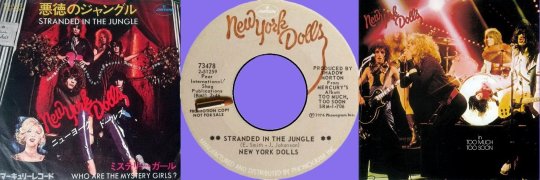
New York Dolls - Stranded in the Jungle (1974) James Johnson / Ernestine Smith from: "Too Much Too Soon" (LP) "Stranded in the Jungle" / "Who Are the Mystery Girls?" (Single)
Jay Hawks Cover | Cadets Cover Glam Rock | Proto-Punk | Novelty Song
Tumblr (left click = play) (320kbps)
Personnel: David Johansen: Lead Vocals Johnny Thunders: Lead Guitar / Backing Vocals Sylvain Sylvain: Guitar / Backing Vocals Arthur "Killer" Kane: Bass Jerry Nolan: Drums
Alex Spyropoulos: Piano Backing Vocals (Female): ?
Produced by Shadow Morton
Recorded: @ A & R Recording Studio in New York City, New York USA during 1974
Single Released in April of 1974 Album Released on May 10, 1974 Mercury Records
6 notes
·
View notes
Text


SO! It's no secret I love David Bowie - sometimes I just put on my a playlist of his entire discography and listen to it over the course of a couple days. Because I'm still deep in my BG3 brainrot - here's all the companions in the Modern AU (no appreciable differences to their cannon setting just modern trappings) rocking out and what I think their favorite Bowie Albums would be, with a few words that I think sum up some of the overall themes of those albums that match those characters (I also think they would each like the musical genre of the selected albums).
Astarion – Man Who Sold the World/Diamond Dogs (Glam Rock/Hard Rock) Decay, Defeat, Ennui
Wyll – Black Tie White Noise/"Heroes" (Art Rock/Jazz Rock/R&B/Soul) Love, Warmth, Triumph
Gale – The Rise and Fall of Ziggy Stardust and the Spiders from Mars/Reality (Glam Rock/Proto-Punk/Pop) Stardom, Grief, Burnout
Shadowheart – Blackstar/Heathen (Jazz Rock/Experimental Rock) Crisis, Death, Acceptance (and faith/crisis thereof, of course)
Karlach – Let's Dance/Aladdin Sane (Hard Rock/Post-Disco/Dance Rock) Conflict, Service, Duty
Tav – Low/The Next Day (Electronica/Ambient/Art Rock) Resignation, Aggression, Solitude (These are also my TOP favorites since she's my character, but it's very hard to pick and I like his whole discography.)
Lae’zel – Earthling/Never Let Me Down (Industrial Rock/Jungle/Hard Rock) Alienation, Wonder, Curiosity
Minthara – Outside/The Buddha of Suburbia (Experimental/Industrial Rock/Avant-garde Jazz) Violence, Confusion, Horror
Halsin – Hours/Young Americans (R&B/Funk) Patience, Memory, Loneliness
Jaheria – Tonight/Hunky Dory (Dance/Art Rock/Pop Rock) Loyalty, Trust, Remembrance
Minsc – Lodger/David Bowie (New Wave/Music Hall/Baroque Pop) Head Trauma, Unease, Immaturity (I also just think the idea of him bopping around to ‘Love You 'Till Tuesday’ is very funny)
Of course I could do an '...in this essay I will...' bit but I'm at least trying to be brief...
#Bg3#baulders gate 3#David Bowie#Modern AU#Art#Personal#Sketch#Digital#Color#Astarion#Gale#Wyll#Karlach#Shadowheart#Lae'zel#laezel#Minthara#Halsin#Jaheria#Minsc#Tadfools#Tav#Zatavia
95 notes
·
View notes
Text
Nearly all the megafauna we associate with Africa today is immigrants. For the last 30 million years or so, its dominant mammalian families have been Bovidae (antelopes, gazelles, gnus, buffaloes), Giraffidae (giraffes), Hippopotamidae (hippos), Camelidae (dromedaries), Felidae (lions, leopards), Canidae (jackals, wild dogs), Hyaenidae (hyaenas), Rhinocerotidae (rhinos), Equidae (asses, zebras), Hystricidae (African porcupines)... nearly all came from outside. Mostly Asia; some from America! (The big exception is elephants).
For the first half of the age of Mammals, say 60 to 30 million years ago, Africa was an island-continent, cut off from the rest of the world by the warm currents of the Tethys Sea:

(Map by Chris Scotese; other pics from Wiki unless noted otherwise)
And, much like Australia in later times, it had developed its own unique fauna of endemic mammals, unknown in the rest of the world. It mostly formed a single clade, appropriately called Afrotheria, which had branched off other placentate mammals in the time of the last dinosaurs. And what were these Afrotheria?




Some of the smallest are still among us. Tenrecs and golden moles (order Afrosoricida), elephant shrews (order Macroscelidea), and hyraxes (order Hyracoidea), the African answer to hedgehogs, moles, shrews, and rabbits, respectively. They are not closely related to their Amero-Eurasian analogues, but they live in much the same way, and much in the same way they did when Africa was an island.

But some of them could grow quite large! Alas, Titanohyrax is known only from its jaws. Thankfully, the jaws and teeth of mammals are very distinctive and allow very precise identification.
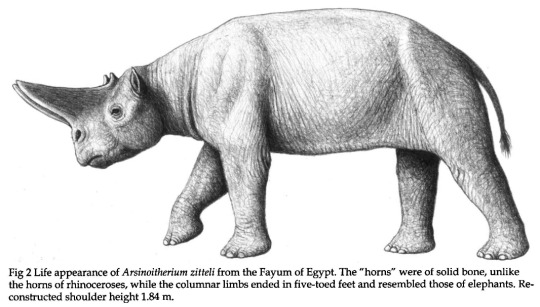
And as for the true giants? Behold magnificent Arsinoitherium (order Embrithopoda), which was a rhino before there were rhinos. No close relation -- in fact, its horns were hollow cones of bone, whereas those of rhinos are made of solid keratin, like giant fingernails. (Sketch by Mauricio Anton, from this wonderful paper by him and Alan Turner).

Then there were the early Sirenians, the still only semi-aquatic ancestors of dugongs and manatees (and the first who broke containment: the proto-manatees Pezosiren and Prorastomus ended up in Jamaica when Africa was still an island, and they still had legs!)

And of course there were early Proboscideans, the grandparents and granduncles of elephants, like Moeritherium, who roamed Egypt when it was still a tropical swamp...
But no isolation lasts forever. Around 40 million years ago, Africa had drifted close enough to Eurasia for some animals to cross through the Tethys. As the seafloor was crushed between continents, the smoking islands that would become Italy, Greece, Turkey, and Iran were rising in between.

Among the first to cross were Primates, such as Afrotarsius, a sort of midway between tarsiers and true monkeys. They did well in the jungles on both sides of the Tethys, spawning macaques, vervets, langurs, baboons and eventually, in the woodlands around Lake Victoria, the first apes.
Another such groups were Rodents -- specifically the Phiomorpha subgroup, in which we find all sorts of distinctly African species such as Old World porcupines, cane rats, and naked mole rats. This is to say that Primates and Rodents did well for themselves after sneaking in.
But then, 30 million years or so, Africa crashed into Eurasia. All barriers to migration went away (well, they came and went with the sea level, but the point is, Africa was no longer super-Australia anymore). And then what we think of today as "African fauna" rushed in.
Here is what African macrofauna looked like at that point, as ungulates and carnivorans were starting to show up:
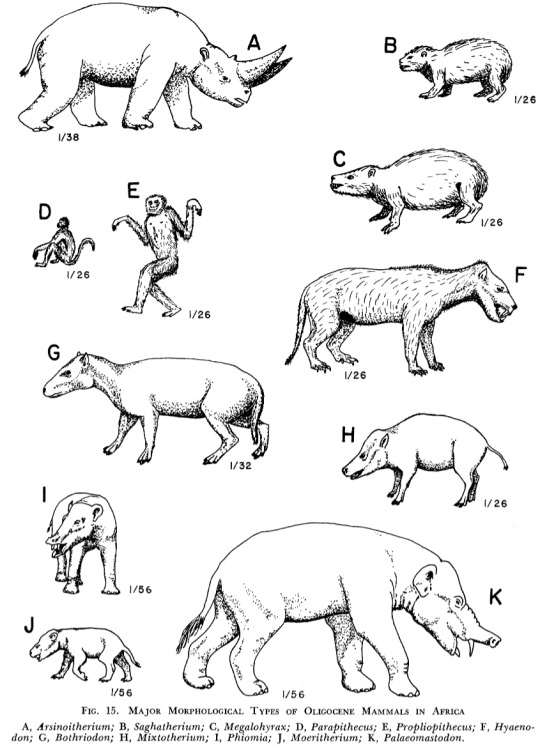
(H. B. S. Cooke, 1968)
The usual rule of thumb is that when two landmasses meet, the faunas of the smallest and/or most isolate landmass lose out. The later interchange between North and South America is a more famous example, but this is no exception.

The great Embrithopods vanished forever; other orders were relegated to small, humbler sizes. In came Bovidae, Giraffidae, Hippopotamidae, Rhinocerotidae, Felidae, Canidae, Hyaenidae, all sharpened by competition on a larger scale in the great grasslands of Eurasia. In came Equidae and Camelidae, which had appeared in North American plains alongside pronghorns (where did you think llamas come from?), and had gone all the way through Bering and Asia.
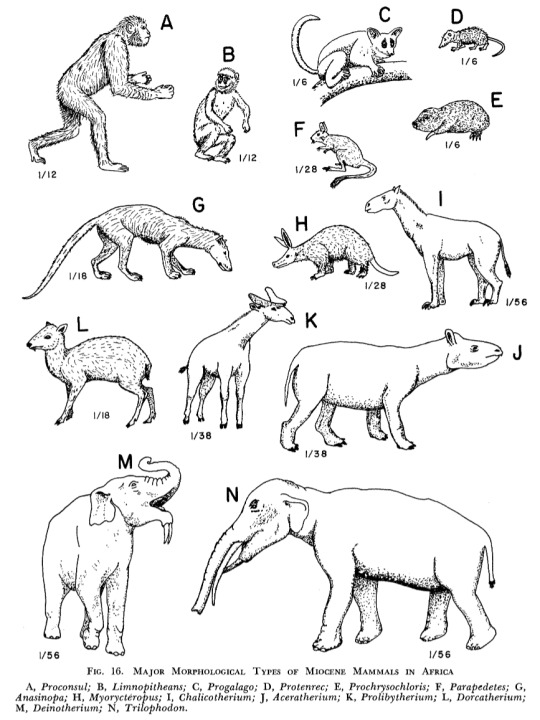
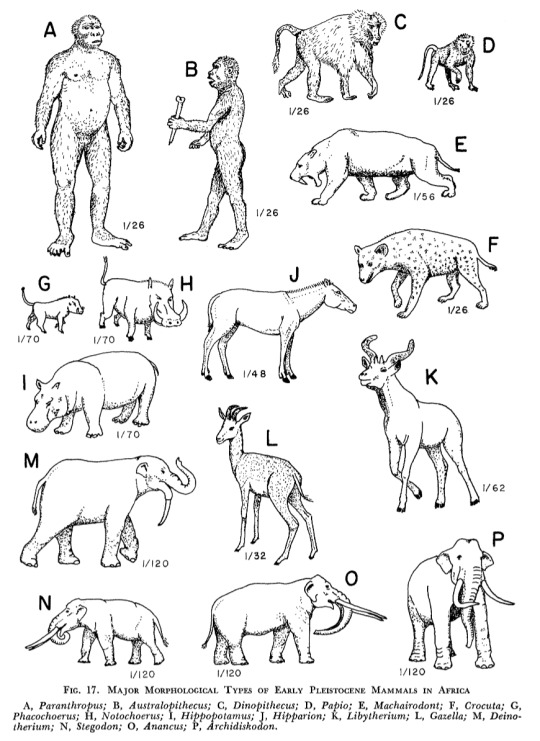
And by later ages, you see it yourselves: elephants and apes actually do quite well, but Eurasian carnivorans and ungulates now rule the land.
To be fair, many groups of pre-invasion African fauna did more than just endure. In the Miocene epoch, soon after the great exchange, apes would be found throughout Eurasia from Spain to China, and perhaps some key part of our own evolution took place there. Elephants were even more widespread, getting as far as South America; manatees invaded warm seawaters all around the Equator. Rock hyraxes and African porcupines had some success in the Near East and southern Europe. But I don't think any of these transformed the Eurasian landscape on the same scale as the African landscape was.
And to be sure, the newcomers were impressive!

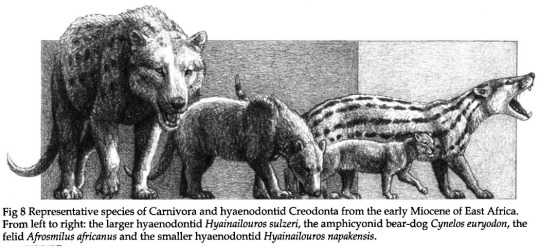
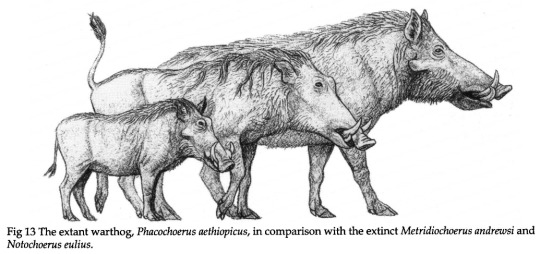
The wheel of ages turns and turns, caring little for who thrives and who falls -- but life as a whole, somehow, always falls on its feet.
29 notes
·
View notes
Text
Okay so today I watched a four part history of themed entertainment in the 90s by the Youtube channel Poseidon Entertainment (the first part is here, there doesn't seem to be a playlist) and it had many bonkers moments of history. Here are some of them:
The MGM theme park in Las Vegas was not allowed to use any MGM films or even the lion in their logo, bc of the terms of mutual lawsuits between MGM and Disney (MGM was mad they licensed their name to a theme park - Disney-MGM Studios - and Disney operated it as a movie studio also, Disney was mad MGM opened a theme park while licensing their name to theirs)
Fashion Cafe was founded by a man named Tommaso Buti, along with his brother. He pretended super models were co-owners of the restaurant (in reality they were just promised profit shares in return for appearing at the opening) and in 1998 it came out that Fashion Cafe had gone months without paying taxes. It shut down later that year, and (this isn't in the video but I'm learning it now) Buti was able to parlay his connections from his short-lived failed fashion-themed restaurant into a gig running Donald Trump's modeling agency. He was later brought up on charges of massive fraud used to fund Fashion Cafe, but was pardoned on the last day of Donald Trump's first term
The founder of Rainforest Cafe, to prove the chain's viability, built a proto-Rainforest Cafe in his house, and the unusual energy use from running a fake jungle full of robot animals in his house got the cops investigating him on suspicion he was making drugs
Anyway go watch it I guess
19 notes
·
View notes
Text
me trying to figure things out re: proto-fiend lore in smtvv and my vanilla smtv headcanons for pre-aogami susano-o... by obvs writing a susano-o/tsukuyomi pwp :|
well anyway here's a teaser
-
Summer. Tsukuyomi’s most hated season and yet the most inescapable. As the world entered a warming state due to humanity’s breakneck technological progress, Tokyo sizzled more and more with each orbit of the sun, and the jungle of concrete and glass only amplified this inescapable heat to the point where even demons were put in a state of lethargy and disgust - and the Proto-Fiends were no exception to this rule.
Crafted by human hands, the Proto-Fiend bodies were inherently flawed compared to their more divine kin, yet they brought advantages with them that other demons coveted jealously: Proto-Fiends were capable of growth and change, trading additional vulnerabilities for the advantage of human ingenuity strengthening them. Of course, Amaterasu, Susano-o and Tsukuyomi were free to spurn the Proto-Fiend bodies to take upon their far more divine yet stagnant forms, but they were long used to this arrangement their father had made with humanity by this point, and so usually stuck with their flawed yet limitless bodies.
However, it seemed that even Proto-Fiends weren’t immune to excessive heatwaves, especially humid heatwaves, which has resulted in Tsukuyomi’s current predicament…
“Ugh. This damn heat…”
The moon was naught but a tiny sliver in the sky, the stars concealed behind patchy yet thick clouds that contained the sticky, humid heat pressing down upon Tokyo. The night hadn’t brought cool relief like Tsukuyomi had hoped, and his little trip to Inakuma shrine for some privacy turned out to be very ill-advised as a result. As claustrophobic as Bethel Japan HQ could be sometimes, it had air-conditioning.
Tsukuyomi, sprawled out on the concave roof of his shrine, scowled at the starless sky above, genuinely contemplating shedding his current Proto-Fiend form until this oppressive heatwave had passed. It wouldn’t be too much of a hardship for the humans to construct him another vessel - Tsukuyomi was cautious enough that they had enough bodies for him to die several times over in one evening before they hit the emergency stocks - but the problem was that Susano-o and even Amaterasu wouldn’t let him forget it.
too weak to endure even a little bit of heat, they’d no doubt tease, and Tsukuyomi’s pride refused to hand them that ammunition. It was bad enough that he was the weakest among them as it was, with an identity that was ephemeral and being steadily consumed by pop culture and commercialism (the less said about Susano-o discovering ‘sexy anime Tsukuyomi’ from human entertainment, the better), but confirming their suspicions on his constitution and having them mock him, or worse, pity him? Tsukuyomi would rather suffer instead.
So he sulked out here instead, in the privacy of his shrine, slowly cooking alive in his Proto-Fiend body. Maybe for next summer he should press-gang a bunch of Jack Frosts into service… make them create a giant snowstorm localised right here… that would be lovely…
A sudden surge of ozone and a blissfully cool gust of wind stirred the stagnant air, heralding Susano-o’s boisterous arrival onto the scene. Tsukuyomi closed his eyes, too exhausted and hot to feel annoyed about his brother’s intrusion. This may as well happen. If he ignored him maybe he’ll just go away.
“Brother!” Susano-o boomed obnoxiously, the acoustic of the shrine making it echo like thunder as the oaf lumbered over. Tsukuyomi practically heard every heavy stomp of Susano-o’s feet. “Brother, are you here?”
Tsukuyomi ignored him.
Susano-o harrumphed loudly, muttering something too low for him to hear. After a moment, Tsukuyomi heard the thump and creak of his brother hauling himself up onto the shrine’s roof, the structure groaning in protest from his considerable bulk - and inelegant way of climbing! What was he doing, kicking footholds into the wall?
“I’m getting too old to climb after you like this, brother!” Susano-o bitched, only to be interrupted by the sound of clattering roof tiles and-
SMASH!
“Ah, shit. Fuck,” Susano-o said. “Crap.”
“Stop destroying my shrine,” Tsukuyomi mumbled half-heartedly.
“He lives!” Susano-o proclaimed, and Tsukuyomi grunted when he felt his brother’s large hands grasp his shoulders and give him a shake. The back of his head whacked the roof a few times from the vigorous shakedown his brother gave him.
“I feared the worst, seeing you lie here so still!” Susano-o said with his usual needless dramatics. “Whatever is the matter with you, brother! Why- ah, why are you naked…”
“I’m hot,” Tsukuyomi admitted. He couldn’t think of any other reason that wouldn’t have Susano-o twisting it to something deviant and weird. “So I stripped.”
“I see…”
#smt5#smtv#shin megami tensei 5#shin megami tensei v#hayao koshimizu#tsukuyomi (smtv)#susano-o (smtv)#fanfic#listen i love the doomed yaoi that is susano-o/tsukuyomi#if only for the tasty tasty angst that aogami's whole situation brings#also fun thinking how their past iterations were like before smtv
22 notes
·
View notes
Note
I think what you've said has made me realize that I actually have a good shot at handling a homosexual relationship from a Christian lens in one of my WIPs.
1: the majority of the cast would be Christian, which means I can have characters explicitly denounce it on the grounds of sin and risk to the soul rather than it just being gross or nontraditional. and most importantly: I can have characters clearly voice this out of love and concern without that being dismissed as a crazy, stupid, or hateful thing to do.
2: it's a period setting where deep platonic love is highly valued, as well as where adoration and physical affection are much less sexualized, so the line between homosexuality and passionate same-sex friendship is clear (which an explicit homosexual relationship ironically makes clearer, because now you can't just say all the male friends are gay when it's shown what that would actually look like)
and it's lack of cultural romanticism around the subject would allow me to include more of the common negative features that don't get included as often in modern media.
3: it's based on a prior work that also included things like incest and adultery, which means I can keep it from being singled out as a special kind of sexual immorality by making sure to address them all the same way. humanizing the people in those relationships would be especially useful for fully addressing the false dichotomy that you usually see of either denouncing sin or recognizing people's humanity. I've noticed a lot of media seems to handle incest the way it used to handle homosexuality: as a just weird and gross (but not spiritually harmful) thing that nobody sympathetic would ever do, which is very concerning, so... two birds with one stone!
4: one of the characters already has a sort of proto-"love is love" philosophy applied to a different issue, making them a good fit to explore this topic through, as it's still perfectly in character and most of the preexisting points of discussion still apply.
they're also caught in a sunk-cost fallacy situation motivated by a lot of complex interpersonal issues like trauma and a sense of being too broken for God to accept, which is a common sentiment/struggle in LGBT circles that I think is also really important to address.
bonus: you can imagine how the fandom is really motivated to proudly put this stuff everywhere in their personal interpretations and projects, so it is a place that could use the presence of an earnest Christian lens.
I'm flattered anything I said was helpful to you, thanks for keeping me in the loop! I'm sure your story is going to be awesome.
I want to ask, though: how does your homosexual character's story end?
I think it needs to be resolved.
I think you need to either condemn the act of indulging in/celebrating homosexual behavior, or reward the act of repenting of homosexual behavior/not celebrating homosexual behavior.
I don't think it's enough to have some characters lovingly rebuke it, or frown upon it, within the narrative. I think the narrative itself needs to reward or punish the topic relevant to how the arc ends.
For example, when Clayton is savagely slicing through the jungle with his sword, the same way he did when we were introduced to his character—a quick visual representation of how he refuses to stop stubbornly trying to conquer the world he's in—he slashes through the ones holding his body weight, causing him to hang himself and die. Something that looks like an unlucky accident on paper but is clearly "this is what happens when you're doing something wrong" from the storytellers.
I think that's important because it leaves less room for misinterpretation. It also reflects reality better. The ultimate reason not to indulge in homosexual behavior is because there is a God who says it's wrong, a Higher Power who didn't create you to be that way. And He must and does ultimately punish all sin. Just like He must and does forgive those who repent.
Your story needs to reflect that truth, that part of reality. It's not enough to leave room for people to say, "some characters disapprove of this lifestyle, that's a perspective that exists." Even if it just looks like the one vine that "happens" to stay intact is the one around the villain's throat.
Also, word of warning--I don't know how much homosexual "romance" factors into your story. But I caution against spending a lot of time building and exploring that romance. You wouldn't build and explore the act of pornographic sex to make your point, for similar reasons.
15 notes
·
View notes
Note
Could I hear more of your thoughts on Doc Savage and the archetype he created? How does it relate to modern superheroes more specifically Reed Richards? (I know that you dislike Doc Savage, so sorry if this bothers you.)
Sorta like this, if we take a look at how Doc's archetype was formed and consolidated, and how that affected the Superheroes and Reed Richards specifically. (also please don't apologize, you all can ask me questions about whatever, seriously)
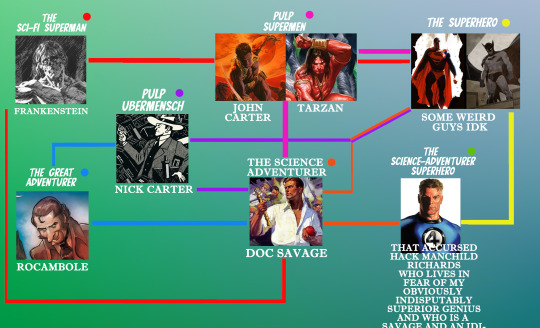
"Doc Savage" is recognizable in lots of other characters but there is a difference between specific pastiches or tributes or parodies of Doc (Doc Samson, Edison Rex, Jonas Venture), and characters who are evoking Doc Savage as his own archetype to draw initial inspiration from (Tom Strong, Bane, Clark Kent), and if we pull at Doc's roots we're gonna get to prior characters like Tarzan and Sherlock who were the ones to introduce or codify much of what are now commonplace superhero traits or the ones to introduce much of what Doc was originally pulling from.
I wanna draw some lines in the sand separating what is it that these characters brought to the table, in the road to get to Reed Richards and what exactly is it that Reed and Doc have in common vs things they have that are mainly taken from characters before them/grandfathered in their respective mediums. So let's go over the Archetypes here:
The Sci-Fi Superman: Coined by Peter Coogan. Through some strange birth or scientific intervention, these characters have superhuman powers and abilities that set them irrevocably apart from humanity, nearly forcing them to usually fall into the roles of saviors, rulers, destroyers, or ostracized/self-imposed hermits. Unless they find a purpose requiring said abilites, they cannot be permitted to exist and usually meet a tragic demise or is stripped of said power. Formative example is The Creature from Frankenstein (Mary Shelley), and others include Hugo Danner from Gladiator (Phillip Wylie) and Bill Dunn from The Reign of The Superman (Jerry Siegel). Coogan considers John Carter the first wholly positive and heroic SF superman, which is disputable, but more on Carter later.
Pulp Ubermensch: The Great Man turned do-gooding adventurer with a prosocial agenda. A human who is physically, mentally, and/or morally superior to those around him as a result of training/upbringing, skilled at everything the story requires him to, who applies his talents and abilities near-exclusively to fight evil. Formative example is Nick Carter (created by John R. Coryell and penned by Frederick Van Rensselaer Dey), who established much of what would eventually become pulp hero and superhero convention consequently.
The Great Adventurer: I'm naming these as a counterpoint to The Great Detective, the fantastical globetrotting adventurer/explorer hero who can go anywhere and do anything, who takes to the world as the detective takes to the city. The idea of a wealthy, offbeat, yet good-natured pulp hero who goes around righting wrongs with like-minded assistants. Formative example here is Rocambole (Ponson du Terrail), in most ways a definitive early Pulp Ubermensch, and arguably the first proto-superhero to assemble a gang of odd companions with a variety of talents and backgrounds to aid him, which is what both the Fabulous Five and the Fantastic Four can trace roots back to.
Pulp Supermen: Offshoots of the Sci-Fi Superman as adventure protagonists in serialized stories, where their superhuman natures and status are alleviated and redirected by the need of their capabilities somewhere or in service of something, and thus they get around the ruler/savior/destroyer fate by being heroes with a social calling akin to the Pulp Ubermensch, dedicated to use their powers near-exclusively to fight injustice without rocking the boat of society by their presence (or if necessary, assert dominion ONLY in a setting outside of human society, such as the jungle or Martian civilization). Distinguished from the Pulp Ubermensch by their greater larger-than-life explicitly superhuman abilities, that they don't need to be morally/mentally superior to the extent of a Pulp Ubermensch, and by the fantastical settings and tone of their adventures. Formative examples are John Carter of Mars and Tarzan of the Apes (both created by Edgar Rice Burroughs), with Tarzan quoted by Lester Dent as a specific influence on Doc (there are others but we're skipping most of those not relevant here)
The Science Adventurer: A frequently-used name to describe Doc Savage and Doc Savage-alikes. Doc Savage can be described, in archetype word salad terms, as a Pulp Superman who calls upon the Pulp Ubermensch's great man-ness and urban social calling, and who combines a Sci-Fi Superman origin and physical traits with The Great Adventurer's explorer disposition, righteousness and band of companions. The main thing that sets him apart from the characters listed prior is his focus on scientific prowess, technology, reasoning and polymathic skills, the importance of the "Doc" part of his name as it where.
The Superhero: you already know what these are and how they relate to the above. I've written a couple of things about the differences between pulp heroes and superheroes and it's a subject I'm of constantly mixed opinions on even regarding stuff I wrote, so I'm linking these two written a year apart if you want an idea of where those differences are.
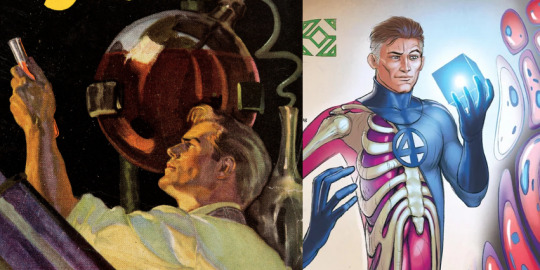
And so we get to Reed, who I'm naming a Science-Adventurer Superhero as a merger of the last two. Both Stan Lee and Jack Kirby mentioned several times that they read Doc Savage aplenty during the Depression and it shows in elements such as the Baxter Building (an expansion of Doc's headquarters in the Empire State Building - instead of just the 86th floor, The Four get the entire skyscraper), the specialized aircraft and vehicles, the fights and antagonism between the cantankerous and anti-social Ben Grimm and the smart-mouthed Johnny Storm mirroring the bickering spats between the bestial Monk and the silver-tongued Ham, and of course Beast from X-Men being more closeled modeled on Monk's ape-ish traits and scientific expertise (there's a fairly large argument to be made, that I think accounts for some of why Beast is, like that, in recent comics, that Ben Grimm and Hank McCoy both divided Monk Mayfair's every trait between themselves and ultimately flipped the script in the long run before taking it to the farthest extremes possible as polarized opposites of each other, with Ben initially getting most of the bad parts and making them the best ones, and Hank initially getting all the good ones and making them into the worst ones)
As far as I know, Reed Richards was not consciously modeled after Doc Savage (although Jack Kirby and Joe Simon's Private Strong used the origin story of a professor raising his son in a lab to be perfect in total isolation of other humans, which Lester likely may have pulled from Phillip Wylie's The Savage Gentleman to begin with), although it's commonly said that the direct precursors of the Four, the Challengers of the Unknown, were modeled after Doc Savage and the Fabulous Five's make-up. The members of the Fantastic Four are all based on 50s sci-fi archetypes, with Reed as the quintessential scientist, the grey-templed pipe-smoking patriarch frontman of the expeditions, and some creators over the years seem to have drawn upon Doc Savage as a model Reed. I'm thinking specifically of Mark Waid here, who openly named Doc Savage in his pitch bible:
The eternal problem with Scientifically Inclined Genius Adventures, the reason they don't ring true, is because in real life scientists spend all their damn time in the lab. Not Reed.
F'r pete's sake, we know he undertook all sorts of Indiana Jones missions as a younger man, we've seen that he actively enlisted in a war, and oh yeah, he stole a rocketship and tried to take it to the moon."
Tommy B put his finger on it when he suggested I stop thinking of Reed as the Professor from Gilligan's Island and instead think of him more like Doc Savage. When Reed encounters mental or logistic obstacles in his quest for knowledge, he thinks through them.
Doc Savage, of course, isn't the perfect model - he's a little more blood-and-gristle than Reed, more invested in the search for justice than for knowledge, and a little more "in the moment" as a general rule. Reed's more like Peter Weller as Buckaroo Banzai, they have the same aloof, detached nature. Unless active danger is staring him right in the face, Reed often seems a bit distant and not completely here because his mind is ten minutes in the future.
That addresses the Science-Adventurer aspect, which leaves us with the Superhero side of the equation.
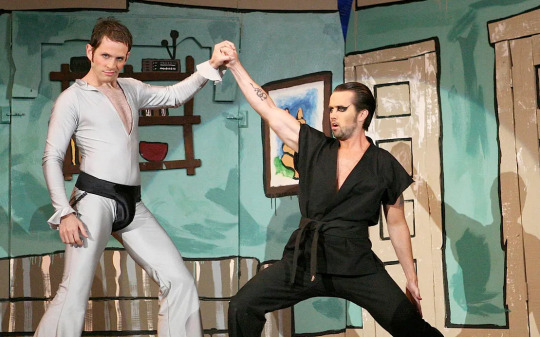
With Doc Savage you of course have one of the, if not the, main archetypal pulp heroes, a character that both Superman and Batman would take a great deal from, and "pulp hero" in itself is a term that exists to define these characters more so in relation to superheroes than what they were actually like in their own stories, time periods and mediums. The superhero as a concept is founded on Superman and Batman and their dychotomy. Costumed Avenger vs Ubermensch, mortal and immortal, light and dark, Dayman and Nightman (AHH-ahhh-AAHHHHH!), and that dynamic is specifically a result of Superman and Batman being direct descendants from Doc Savage and The Shadow respectively, who were Street & Smith's (and by extension the American pulps) Big Two, the top dogs of 1930s hero pulps, and direct opposites to each other.
Doc Savage was created in response to The Phantom Detective (who was the first successful Shadow imitator and thus defined it as the thing everyone was gonna have to do or respond to) and was in many ways a modernized revamp-almost-copy of Street & Smith's Nick Carter during his heyday, in origin and first case and super strength and omnicapable skills and general Great Man-ness and gadgetry and mission statement and so on. Doc was co-created by the editor of Nick Carter Magazine, John Nanovic, and the first response to the Phantom Detective that S&S planned was a reboot of Nick Carter as a generic hardboiled detective, published on March 1933, the same month as Doc's debut, and obviously Doc would go on to achieve much greater success and thus would popularize those traits again with himself as the figurehead archetype of them (not unlike what Superman and Batman would later do).
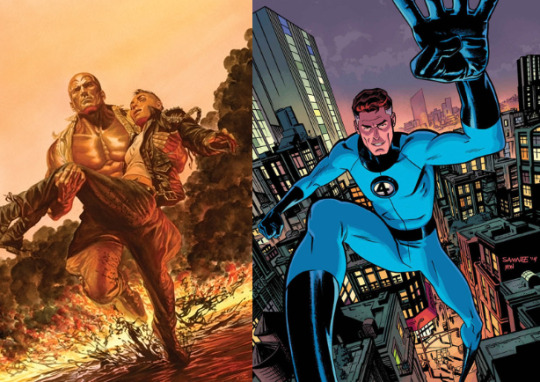
Unlike The Shadow, Doc Savage does not operate under a secret identity or mask. He is not the hidden master of the city and has no division between his alter egos, and because he performs in broad daylight as a celebrity, is theorically held to social scrutiny, and is fully sanctioned and approved by law enforcement and works with the authorities with public transparency (minus the crime college but let's just, not, for now), it greatly upends and affects the approach he takes to fighting crime. He only has one identity, the greatest man of all time as the stories will remind you at every turn, by his author's own words he "manifests Christliness", and while not much separates Doc Savage's skills from Nick Carter's, he is explicitly and textually framed as superhuman (even a "superman", that term was deployed a few times), and he operates in a contemporary, urban setting that most Pulp Supermen cannot touch without veering into Sci-Fi Superman territory.
Within the hero pulp format that S&S started with Nick Carter and renewed with The Shadow, with the scientific explorer angle, you could argue Doc Savage, in almost exactly the same way as he does in his stories, worked out the solution to an unfixable problem: Turns out you can be as over-the-top super as you want, so long as you have a procession of equivalent super menaces to fight, don't upset society (and if you do it, not where the public where can see, keep it a secret that you can be blackmailed over by crooks you will inevitably silence okay look I'll stop now), have whatever incredible miracle cures and achievements and charity you do work on take place off screen where you never have to deal with them too seriously, and know how to pick your fights.
His service to others resolves the ruler/savior/destroyer conundrum. Savage aids individuals who face problems beyond their control, does great work in advancing medicine and science, and alleviates suffering through charity work, but he leaves the institutions of society in place.
He faces a never-ending succession of villains threatening society, an eternal frontier of gangsters and super-scientific menaces who play the role that Indians take in frontier narratives. The unresolvable nature of crime makes this frontier eternal, so Savage can place his superiority in service to the community and never risk turning into a ruler, savior, or destroyer because he can find challenges sufficient to absorb his energies.
The Savage solution—the hero position would be adopted by the creators of other prosocial supermen to come, including Superman, although only the adventures of Superman would be set in contemporary America.
Thus instead of marking an end to the bourgeois domination of society, as Nietzsche foresaw, the superman serves to protect that domination through myth-narratives. - Superhero: The Secret Origin of a Genre, by Peter Coogan
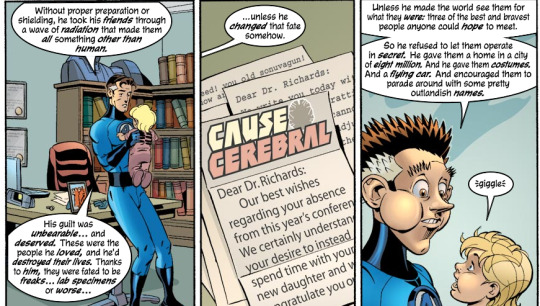
Reed Richards, in turn, is defined (INCORRECTLY, I say, feeling a plasma crackle barely miss my skull) as the smartest man on the planet, a mental superhuman who operates on a level above and beyond that of everyone around him, and a freak accident during a space travel grants him physical superhumanity to match, with his body able to morph and bend under his will. He alleviates the ruler/savior/destroyer conundrum Coogan described in much of the exact same way described above, kept busy with an endless procession of strange dimensions and aliens and supervillain challenges, and Mark Waid's famous confession scene in Fantastic Four #489 addresses the fate that looms over the Sci-Fi Superman directly, with the "very arrogant man who did something very stupid" pointificating to his toddler child just how necessary it was to ensure that the world would not fear and destroy the people he'd irreversibly mutated as a result of hubris, what is even the point of his grandstanding title and colorful outfit and public adventures and all that.
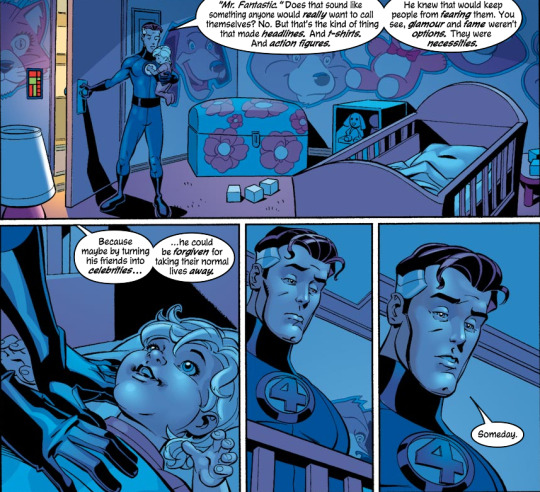
The life of superpowered adventurer celebrities was a necessity, and his superhero persona, Mr Fantastic, is a tabloid-catching act of penitence to mask his ultimate shame and to compensate the people he loves most. He lives for science, he craves discovery above all, but as far back as the Lee/Kirby stories, he still drags the team into awful intrusive press conferences none of them want to go but must, he sits through meetings with hardass generals to buy his team more leeway and trust, he takes the time to stretch across the city to visit sick children in hospitals and say hello to passing helicopters, he has to be the stick-in-the-mud dad who stretches himself thin to keep Johnny and Ben from ditching the team or seriously hurting each other (those first Johnny and Ben spats get way more violent than you'd expect), and he has to make difficult and even manipulative and harsh decisions even then to save the most lives he can. He carries a responsability to his family and loved ones first and foremost, and fashioning himself and them into superheroes is how he lives up to that responsability. It's what allows them to exist and thrive in-universe as much as out of it.
(We're not gonna play catch-up to the "why doesn't Reed Richards cure cancer" conversation but even that, in itself, is an extension of a thread that we can trace back to Doc and the Sci-Fi Supermen before him, when seams in the fantasy start showing with the introduction of consequence, a trend that particularly catches up to these scientist superhero characters who followed in Doc Savage's wake, and obviously caught up to Doc himself several times by now, for reasons @artbyblastweave describes as "a consequence of contemporary writers being Allowed To Notice And Unpack Things" and elaborates on very neatly here)
As a superhero, Reed Richards exists in conversation with Superman and Batman, same as every other character within the superhero "genre", which means he also exists in conversation with those traits borrowed from Doc Savage, and The Shadow, and all these other guys listed who were crucial in their development and a lot of others I'm leaving out of the conversation for now. A crucial part of that conversation and where the Fantastic Four figure into it is the fact that they were designed to not be traditional superheroes but to flip most if not all the conventions established on it's head, a part of that being their initial lack of uniforms (and when they did get uniforms they were just that, uniforms, rather than costumes), the lack of a secret identity, and the fact that the Four are scientists and explorers first, and crimefighting superheroes a distant second they're forced to frequently make a close second or first priority. Marvel made it's big defining pop culture splash with the Fantastic Four by turning superhero convention on it's head and doing as much as they could to do the opposite of what Brand Echh was doing.
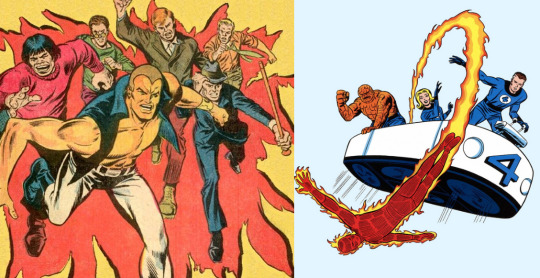
And that's kinda the main reason they end up inviting similarities with Doc Savage and other pulp heroes, because they're going out of their way to imitate and subvert traits and tropes that Superman and Batman were already imitating and subverting from those guys in the first place, that they in turn were imitating and subverting from guys that came before them, and etc.
Archetypes are breakthroughs, and no breakthrough happens in a vacuum. In the end, a lot of these strands and connections between these characters are less specifically the result of writers consciously following in the footsteps of Doc Savage and those that came before or alongside him, and more so with the fact that there's only so many left turns you can take before you just end up in a circle, or reinventing the wheel as it were.
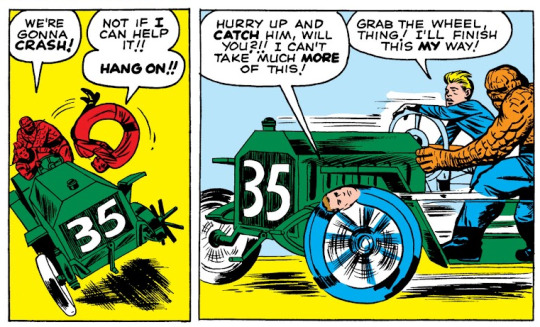
#replies tag#pulp heroes#pulp fiction#superheroes#marvel#marvel comics#doc savage#lester dent#reed richards#fantastic four#stan lee#jack kirby#mark waid#comics
86 notes
·
View notes
Text
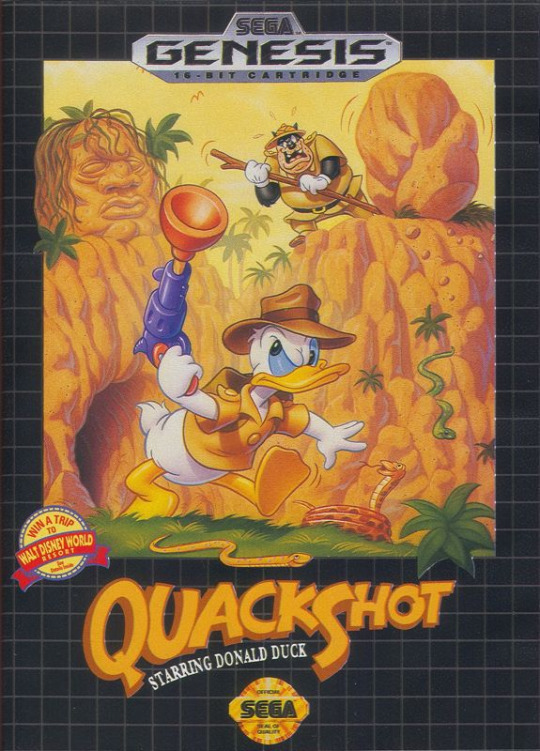
QuackShot Starring Donald Duck
4/5
Adaptation 4/5, fun 4/5
Honestly what a refresher after Batman. QuackShot is just as delightful as we remember it being. It's got that run-and-gun platformer action, but your main weapon is a plunger. It also can't defeat enemies, only stunning them, so you have to ration out your special ammo for when you need them dead. The powerups are given out pretty evenly throughout, and while there's a few "how would anybody know that the first time" moments, QuackShot is mostly challenging but fair.
One of the things that stands it out from other Disney platformers of the time is the exploration aspect of the game. You start with 3 levels, opening up more, and you can explore them in any order, finding dead ends where keys or new powerups are needed. Unfortunately, it's still pretty linear, failing to fully capitalize on the proto-Metroidvania feels, but it's a nice touch and adds to the adventure theming of the game.
Where QuackShot really stands out is in its presentation. The game's just a beautiful showcase for the Genesis. Donald is so well animated, with nice touches like his eyes bulging out a little when you're crouching. The enemies and bosses are fun, fitting in with the classic Disney world, and there's nods to other Disney properties like Jungle Book. Each level sets the mood with gorgeous background art, whether it's ancient temple ruins, the skyscrapers of Duckburg, or the South Pole.
Just a good good time. Still remains one of the best Disney licensed games to us. It's a joy to play, start to finish.
Backloggery
#video games#licensed game hole#quackshot#quackshot starring donald duck#donald duck#disney#sega#genesis#mega drive
3 notes
·
View notes
Text
2000 London Playlist (YouTube)
I've probably written it so many times at this point, but whenever I make one of these largely electronic-focused UK-year playlists, I really can't help but think of just how integral the year of 1988 was to all of this, because that was when the country's youth ended up fully embracing the sounds of acid house that were being imported from Chicago, thus giving rise to the Second Summer of Love. And then almost everything that was either dance or electronic that was made or championed in the UK afterwards pretty much flowed from all of that. Breakbeat, trip hop, drum n bass, jungle, techno, IDM, deep house, trance, big beat, etc.—had acid house not succeeded like it did, I don't know if London really maintains its unanimous status as the world's most musically vibrant city right now. The open-arms acceptance of all these different forms and strains of electronic music really set it up for greatness, and I think almost all of that really goes back to the pivotal year of '88.
And, of course, twelve years later, as the city was entering a new millennium, it was still chugging along strong, producing way too many quality tunes for everyone to fully keep track of, inevitably leading to songs becoming either overly ephemeral or slipping through the cracks entirely. But here, I've picked out some pretty cool London-made tracks from that year of 2000, actually reminding me of the now-deleted first iteration of this blog I once had, when I dug very deeply into a sixty-plus volume series of comps that was issued by Mercedes-Benz called Mixed-Tape. Say what you will about how corny a series like that might sound on its face, but the people at the Mercedes offices who were tasked with putting those things together really had a knack for consistently compiling contemporarily cool and fresh Eurocentric indie and electronic affairs. And with the first volume of that massive series being issued in 2004, I'd like to think that this London 2000 playlist of mine here can be seen as something of a predecessor to it. Plus, the fact that it's focused on just one city, but sounds like a series that more or less dealt with one continent, only goes further to show just how dynamic of a place London really was and still is.
So on here, you're likely to find a bunch of neat stuff that you probably haven't ever heard before: groovy electro-funk and a proto-vaporwave tune that incorporates the dialup sound from Coldcut associates Hexstatic; string-padded tribal techno from James Ruskin; nocturnally city-slicking breakbeat with a Latin touch from Si Begg (the most Mercedes-sounding song on here by far); Christmas-adjacent trip hop nostalgia from Osymyso; Eastern-infused IDM craziness from Bedouin Ascent; ambient dubby drum n bass from Yellow Dragon; and a turn-of-the-millennium house favorite of mine that samples Roger Troutman's iconic vocals from 2Pac & Dr. Dre's "California Love" by an act called The Hydraulic Dogs. And then for a total curveball, goth rockers Gene Loves Gezebel revive their 1990 alternative radio hit, "Jealous," with a soft, acoustic guitar update on it too. Take a look at the play counts on all of these songs, and I think you'll realize that there's no other look back at London from a quarter-century ago that's quite like this little collection I've assembled here.
This playlist is ordered as chronologically as possible:
Hexstatic - "Kids Can Dance" Hexstatic - "Communication Breakdown" James Ruskin - "Detached" MJ Cole - "Sincere (Mig's Petalpusher Vocal)" The Hydraulic Dogs - "Shake it for Me" Si Begg - "Muchacha" David Sheppard & Keiron Phelan - "Theme from Cardinal Menthol" Gene Loves Jezebel - "Jealous (acoustic)" Osymyso - "Eternal Father" Bedouin Ascent - "If.Then.Else" Yellow Dragon - "Jambala"
And this playlist is also on YouTube Music.
So with the first iteration of this playlist, we start off with 11 songs that clock in at a total of 55 minutes. Might take a bit for me to dig further into my collection in order to compile a Spotify playlist too, but I'm definitely planning on getting there someday 🤞.
Back to the 90s next week. No specific city or year though!
Enjoy!
More to come, eventually. Stay tuned!
Like what you hear? Follow me on Spotify and YouTube for more cool playlists and uploads!
#idm#house#house music#downtempo#dance#dance music#electronic#electronic music#music#london#britain#great britain#england#uk#2000s#2000s music#2000's#2000's music#00s#00s music#00's#00's music#y2k#y2k music#playlist#youtube playlist#youtube playlists#playlists#youtube music playlist#youtube music playlists
3 notes
·
View notes
Note
Top 5 Underappreciated Sonic levels, in your opinion
I was holding off on this one because being the weirdo that I am, there's a lot that come to mind, which is what happens when a fandom seems to only care about three or four locations in the whole series. So since I can do what I want with my lists, I'll instead list one per game. :] Not every game, just whichever ones that I can think of an example for.
Marble: the level design is blocky, but I dig the lava ruins aesthetic
Crystal Egg: really unique final zone, I'd love to see another stab at this concept
Hill Top: seems to get more love nowadays, but used to be widely considered the weakest Sonic 2 zone for being Emerald Hill 2: This Time It's Blue, I like it for being another unique take on a lava zone, very proto-Red Mountain
Quartz Quadrant: favourite zone (sorry, round) in CD, and not just cause it reminds me of @greenyvertekins' OC Verte Sinople, though that helps :>
Gigalopolis: an eye-catching city zone, even in 8-bit
Marble Garden: memorable Eggman fight with Tails, also has my favourite music in the Sonic 3 half next to Launch Base
Sandopolis: Act 2 might be a little slow, but I really like the Act 1 aesthetic, so there >:[
Marina Madness: level design is certified Knuckles Chaotix, but at least it looks pretty
Spring Stadium: I could really say any zone in 3D Blast because it's 3D Blast (Rusty Ruin <3, Volcano Valley <3), but I've really grown fond of the funhouse aesthetic here, shame about all the spears and spikes though :P
Radiant Emerald: glad they brought it back in Super Circuit, Double Dash, DS, Wii, this is a funny joke, pls laugh
Final Egg: picking one for SA1 is difficult because I think all of them are liked well enough, but Final Egg tends to get mentioned less frequently than other final levels in the series, and I won't stand for that
Pyramid Cave: probably the least discussed Sonic stage in SA2... well I like it (ghosts touching you inappropriately aside)
Ice Mountain: one of my favourite ice zones and Act 1 tracks
Techno Base: just as great as Music Plant
Egg Fleet: tends to get overshadowed by Final Fortress, I love how with this airship level in particular, the lack of clouds in the upper half of the skybox make it feel as though you're REALLY high up
Twinkle Snow: another favourite ice zone and music, even if the level design is one of the more... yeah
Digital Circuit: better cyberspace than the one in Frontiers (I would like to say Lost Impact for the atmosphere, but the tedium of the actual gameplay overwrites it for me unfortunately)
Mirage Road: underrated banger
Dark Desert: I know I keep mentioning desert levels lol, but a desert town during an eclipse is very striking
Aquatic Base: level itself is certified '06, but the music is S-tier and it paves the way for the greatest Eggman defeated cutscene in all of fiction
Night Palace: see Crystal Egg
Pirates' Island: interesting final zone, also leads up to TE DAVY JOOONES WITH YE
Aquatic Capital: includes Tempest Waterway as well
Jungle Joyride: despite the framerate's spirited efforts to drag it down
Misty Lake: I don't care too much for most of the levels in Black Knight, but Not Kingdom Valley looks nice
Sylvania Castle: aesthetically at least, it's a cool take on an Aquatic Ruin-type area
Dolphin Resort: cool aquarium/shopping mall combo, just a shame it was trapped in Free Riders
Aquarium Park: this has always been my favourite zone in Colours... between this and Dolphin Resort, clearly I enjoy me some underwater tubes
Titanic Monarch: dark and colorful simultaneously, and I don't struggle with it as much as most fans seem to
Mortar Canyon: its biggest crime is how short it is, cause then I can't hear the music :(
Egg Fortress: it might start off as a standard Not Death Egg, but I love the reverse gimmick in Act 2, and I actually like the final boss' brutality because it's Eggman punishing fans for portraying him as a dad ack ack ack ack ack
7 notes
·
View notes
Text
youtube
"Everything will be fine..."
Most creative ideas begin with something very simple. It could be someone unusual you meet, somewhere strange you find yourself, a turn of phrase heard in conversation, or a news article you stumble on one morning while trying to roust yourself with coffee. Or it could be cracking open your parents’ high school yearbook on a visit to them in St. Louis and seeing a photo of your father, only to wonder if you would’ve been friends with him had you lived back then. This is what happened to Bob Gale, who immediately thought it was an interesting hook for a comedy and lobbed it over to his longtime writing partner, Robert Zemeckis, who was then in the midst of trying to salvage a chaotic adventure movie with two temperamental stars in the Mexican jungle. Bob Z, in turn, had been thinking of the character of a mother who always told her children what a prim and proper young woman she was when it fact she had been as promiscuous as all get out. The pair quickly fused the two ideas with the concept of traveling through time and set about building the story for what would become one of the truly perfect film comedies of all time, “Back To The Future.”
When the film was released in the summer of ’85 (after considerable script changes and the MASSIVE casting swap of changing the lead actor midway through shooting), I knew nothing about it beyond the fact that it was led by that pipsqueak Alex P. Keaton from “Family Ties” and the effervescently loopy Reverend Jim from a favorite sitcom, “Taxi.” Back then personal computers weren’t a glint in the eye, and all you had to go on were the tidbits you could find in Starlog magazine. One lazy summer day, though, I heard a song from the film on the radio at Lake Nacimiento. This was, of course, the undeniable pop classic by Huey Lewis and The News, “The Power of Love,” and after that I was IN. The film itself was, in retrospect, the perfect summer moviegoing experience. Brilliantly written and structured, flawlessly paced and performed, and shot through with that genuine, indefinable sense of magic that only happens very rarely in films (and as I always say, almost never these days).
On its face, the film’s plot of sounds like something the Big Three networks of the time might’ve based a wacky family sitcom around. What elevates it (and indeed the whole wild and imaginative trilogy) above just being a clever male adolescent fantasy is the way Bobs Zemeckis and Gale took their inspired collision of genres and layered it with heart, captured it with visual ingenuity (humble genius Dean Cundey again) and added a sense of bite and eccentricity to the humor to build something timeless and endlessly rewatchable. They were also gifted with a cast, led by the boundless energy and Harold Lloyd-esque physical comedy of Michael J. Fox and the magical, sentient dervish that is Christopher Lloyd, that included the winsome horniness of Lea Thompson, the fumbling oddball charisma of Crispin Glover and of course the proto Trump, psychotic bully idiocy of Thomas F. Wilson. Topping off the whole grand Lou’s Café milkshake of it all was a sweet, sweeping score by Zemeckis’ longtime musical voice, Alan Silvestri.
For the film’s 40th anniversary, Universal Studios brought the story to life as part of their new “Fan Fest Nights.” The centerpiece of that experience was undoubtably spending time on the small town set of Hill Valley, which still stands on the fabled backlot as a testament to how ingrained in our culture the exuberance of Zemeckis and Gale’s story remains. With prop cars, carnival booths, old fashioned summer food, Marvin Berry’s band and a host of actors breathlessly recreating parts of the film with guests, it was like the block party 10 year old me only dreamt of back in little ol’ Cayucos. The warmth and reverence for the film, and its place in pop cinema history, was palpable and infectious. Whether the films have the same currency in today’s “here today, gone tomorrow” disposable way of engaging with “content” remains to be seen. But for me it will always stand, like “Jaws,” “The Godfather,” and “It’s A Wonderful Life,” as a perfect model of imagination, a loving contraption from some of film’s most creative minds, who came together at a singular point in time and left us all with something joyfully ingenious to share, far into the future.
#back to the future#michael j fox#christopher lloyd#robert zemeckis#steven spielberg#bob gale#universal studios#cinema#1980s movies#1985#classic movies#Youtube
2 notes
·
View notes
Text
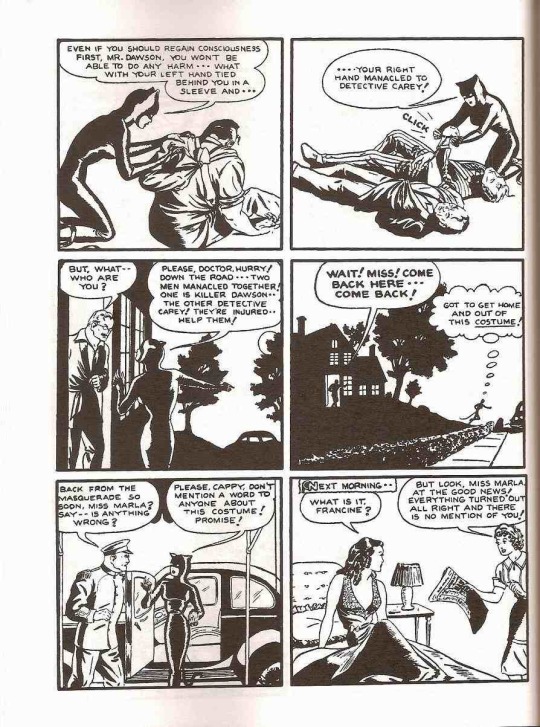
Some say that Miss Fury was the first identifiable female comic book hero in that she adopted the features of the classic costumed crime fighters that followed. She wore a costume and mask, had a secret identity, came from a famous/ well off background and possessed athleticism, fighting prowess and detecting skills, all which helped her to fight crime, often at night. Miss Fury’s real identity was socialite Marla Drake and she was something of a proto-Batgirl with her skin tight costume, mask-and-pointy ears disguise, vigilantism and her propensity for rooftop investigating. Her origins lay in the African jungle when she fashioned her costume from the hide of a “black leopard” which her father had willed her as a curiosity, saying it had belonged to a witch doctor who had claimed it had magic powers. Marla becomes a hero almost accidentally, making her costume as an emergency replacement when another woman wears a similar outfit to hers at a ball. The page above is from her origin story and depicts her capturing the criminal Killer Dawson, again rather spontaneously, after which her interest in secret crime fighting is piqued.
As Miss Fury, Marla takes on Nazi spies, gangsters and assorted criminals attempting to aid the police in capturing hard-to-nail crooks, particularly Marla’s love interest, Detective Dan Carey (despite being engaged to someone else). Engagingly, Marla remained conflicted about her crime-fighting persona, resenting the need for a secret identity, and querying her worth as a crime fighter (quite the opposite of her near-contemporary, Black Cat). Also, as the first of her kind, Miss Fury encountered concern from censorious conservative opinion, who judged her costume too revealing and her antics inappropriate. This may explain her relatively short run of an eight issue series of her own in 1942-43. Nonetheless, the character opened the door to Black Cat, Wonder Woman, Catwoman and a host of other female comic book costumed characters so, in some respects, she is a truly historic figure.
Miss Fury first appeared in a syndicated newspaper comic strip called The Black Fury in April 1941, illustrated by June Tarpe Mills, significantly one of the few women working as an illustrator and scripter in the Golden Age. In November 1941, the strip was retitled Miss Fury. These stories were later collated in the character’s own title. The page featured is from Miss Fury #1 (December 1942).
Source: Marvel Fandom
#women in comics#golden age of comics#miss fury#golden age comic book heroines#strong woman#woman detective#tarpe mills#June Tarpe mills
12 notes
·
View notes
Note
So dr ratio… chicken 🐔 or egg 🥚 very important question.
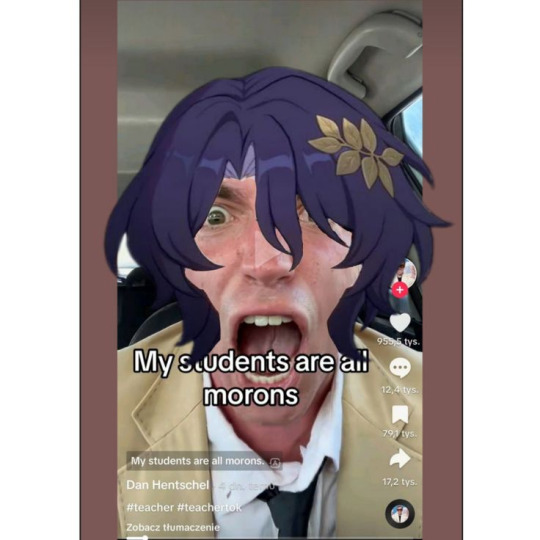
❝ Although the question is typically used metaphorically, evolutionary biology provides literal answers, made possible by the Darwinian principle that species evolve over time, and thus that chickens had ancestors that were not chickens, similar to a view expressed by the Greek philosopher Anaximander when addressing the paradox.
If the question refers to eggs in general, the egg came first. The first amniote egg – that is, a hard-shelled egg that could be laid on land, rather than remaining in water like the eggs of fish or amphibians – appeared around 312 million years ago. In contrast, chickens are domesticated descendants of red junglefowl and probably arose little more than eight thousand years ago, at most.
If the question refers to chicken eggs specifically, the answer is still the egg, but the explanation is more complicated. The process by which the chicken arose through the interbreeding and domestication of multiple species of wild jungle fowl is poorly understood, and the point at which this evolving organism became a chicken is a somewhat arbitrary distinction. Whatever criteria one chooses, an animal nearly identical to the modern chicken (i.e., a proto-chicken) laid a fertilized egg that had DNA making it a modern chicken due to mutations in the mother's ovum, the father's sperm, or the fertilised zygote.
It has been suggested that the actions of a protein found in modern chicken eggs may make the answer different. In the uterus, chickens produce ovocleidin-17 (OC-17), which causes the formation of the thickened calcium carbonate shell around their eggs. Because OC-17 is expressed by the hen and not the egg, the bird in which the protein first arose, though having hatched from a non-reinforced egg, would then have laid the first egg having such a reinforced shell: the chicken would have preceded this first 'modern' chicken egg. However, the presence of OC-17 or a homolog in other species, such as turkeys and finches suggests that such eggshell-reinforcing proteins are common to all birds, and thus long predate the first chickens. ❞ (x)
#incandescentia#MY STUDENTS ARE ALL MORONS!!!!!!!!!!!!!!!!!!!#;crack#crack#/i feel like although he would be able to come up with a scientific response; he would entertain the metaphorical philosophical side mo#*more#/simply because it leads to more debate; he enjoys that#but do NOT mention that; he is not here to entertain your silly ideas -pointing emoji-
6 notes
·
View notes
Note
I've read your treasure seekers rambles and ngl your thoughts on Luke as a villain makes me kinda curious on your opinions on most of the villains in the series as a whole :O
Most of the villains (the older ones, I'd say) are really good. Madame Hu is intimidating and probably a mommy people simp for (also the closest to being a proto!Luke), Mortimer MacCardigan is a properly self-centered dick to root against, Dunya is actually kinda terrifying, the corrupt judges in Dancing Shadows probably hit a bit close to home for the competitive performing artists out there, Sammy Sharkfur is capitalism incarnate-- you get the idea, all of them are really good.
The newer books do vary in quality, and they lean more into domestic-ish travel drama and stuff like that. Which I am fine with, don't get me wrong-- it can be done right, and they are done right (coughs and sips tea loudly at Fiesta in Mexico), but when they aren't they do be boring -m-
And then there are the occasional villains like uh Olaf and Ulfur in Frozen Fiasco, and those guys are hella basic, I'ma be real
They're literally the SKINNIEST TWINKS IN EXISTENCE, WHAT DO YOU MEAN THEY MANAGED TO INCAPACITATE NINE GROWN-ASS ADULTS ALL BY THEMSELVES--
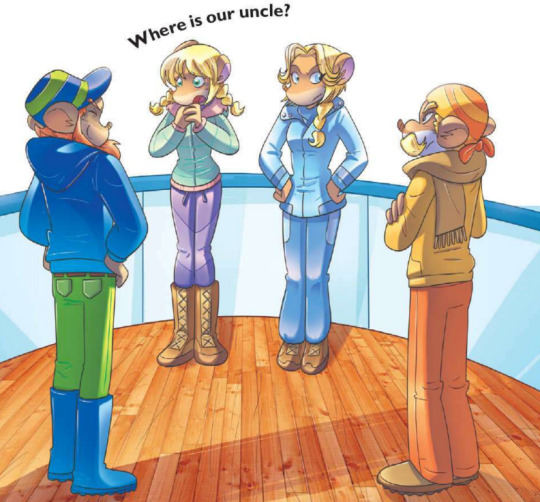
I get they can't use tranqs or guns or anything like that but C'MON A CROWBAR AT LEAST LIKE C'MOOONNN SHOW US A THING WHERE THEY'RE LIKE "If you don't want your friend or the pencil pusher to get hurt, you will cooperate with us" OR SOMETHING THAT JUSTIFIES THEM GETTING YA YEETED INTO A SHED BY THESE T W O T W I N K S
Madagascar Madness was kinda better at it since well, they were in the middle of the jungle and the animal traffickers can wrangle aforementioned exotic animals with perhaps ungodly reaction times/speeds (like lizards/iguanas), sooo at least it's somewhat imaginable and understandable that they'd be able to tie up eight people. They prolly used and abused the lasso tool /j
One notable villain in the newer books is the magician from Venice Masquerade-- that guy was cool, a magnificent bastard who was seven steps ahead until the girls figured out how to anticipate his anticipating. (Kinda. Hoping the misdirection thing Marco did when stumping the magician was just a Scholastic blunder because my god did it sound stupid in the English translation)
Anyway yeah the books do what they do well, but I can't deny that I miss the unabashed evilness of the villains in the old books. We need a little more of a big bad getting up in the girls' business enough for the girls to want to do something about it dammit
It's probably a bit of Scholastic cherrypicking the books to publish because like, we do have like, about 19-ish Thea Stilton books that haven't been translated to English, maybe one of them had a big bad we can root against -m-
But I dunno, we wouldn't know
Because they haven't been translated to English -m-
#geronimo stilton#thea stilton#thea sisters#questions with e#there're less italian main books that haven't been translated than i thought#but there are some ones i'm very curious about#like there's this book called la leggenda del giardino cinese#“legend of the chinese garden” in english#and it has violet's birthday and an adventure in her hometown hangzhou like WAAAGGHHH#paws at the door#scratches#screams#LEMME IIIIIINNNNN#THERE'S THIS ONE BOOK TAKING PLACE IN ARGENTINA TOO AND IT'S ABOUT A FAMILY TREASURE AND MAAAANNN#I WANNA SEEEEE
12 notes
·
View notes